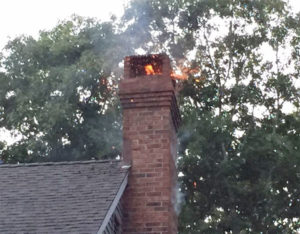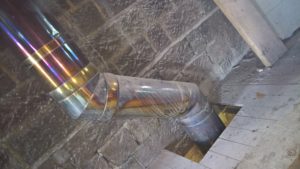



There is nothing better than a roaring log fire or a cosy wood burning stove burning merrily away when it’s cold and wintry outside. But if you don’t look after your chimney or you burn unsuitable material, you are running the risk of a chimney fire.
Have you ever had a chimney fire?? Homeowners that have had the misfortune to suffer a chimney fire report :

Some people have a chimney fire and know nothing about it at all. Slow burning chimney fires don’t get enough air or fuel to be dramatic or visible but they can still cause substantial damage.
Temperatures can reach 1,100 degrees Celsius during a chimney fire. The effect of this is that heat is radiated through walls and any sparks could ignite flammable materials, such as wooden beams that may be nearby.
Even if you can’t see any damage to the chimney breast, it is highly likely that damage will have occurred inside the chimney following a chimney fire. If you have a stainless steel flue liner in your chimney, the liner will need to be replaced as the crystalline structure of the steel changes and it will corrode very quickly if you continue to try and use it. Stainless steel is also prone to buckling and changing shape when exposed to very high temperatures.

Other liners such as a concrete, pumice or a Furanflex liner would need to be thoroughly checked with a CCTV inspection carried out by a professional before being used again following a chimney fire.
Chimney fires are more likely to occur if your flue is not regularly swept. Sweeping removes the dust, debris, cobwebs, bird nests and other items that fall into chimneys that could be ignited by a stray spark.
If you burn unseasoned or wet wood you also run the risk of tar and creosote building up inside your chimney.
When you have an open fire or wood burning stove in your home, the job of the chimney is to provide an outlet for the by-products of burning whatever fuel you are using. These include smoke, vapour, gases, tiny bits of unburned wood, hydrocarbons such as tar and assorted minerals. As these substances move up the chimney they cool down. As they cool, they solidify and end up sticking to the sides of the flue instead – this is where a build-up of tar and creosote comes from.
Tar and creosote can be dark in colour and can look sticky and shiny or crusty and flaky. When the chimney is hot this tar and creosote can melt and vaporise – a stray spark could then ignite this vapour, resulting in a chimney fire.
Interestingly, the way that you use your stove can also contribute to a chimney fire. The main aim for an efficient flue is for the by-products of the fire to move up the flue and exit as quickly as possible before they cool down. It, therefore, doesn’t make sense to regularly use your stove by letting it smoulder at low temperatures as the smoke and gases are not going to escape quickly enough to prevent a build-up of creosote and tar. Always follow the manufacturers’ recommendation for the safe use of your wood burning stove.
If you would like more information on the causes of chimney fires and general fire safety there are various fire and rescue service websites available.
If you think you have had a chimney fire and want a professional to survey your chimney, please contact Turner Baker at head office on 01432 839123 or any of our regional branches:
Cheltenham: 01242 649660
Shrewsbury: 01743 343544
Worcester: 01905 611663
Hereford: 01432 839123
Oxford: 01865 236763
Bristol: 0117 336 0470
Cardiff: 02921 151303
Leamington Spa: 01926 257404



